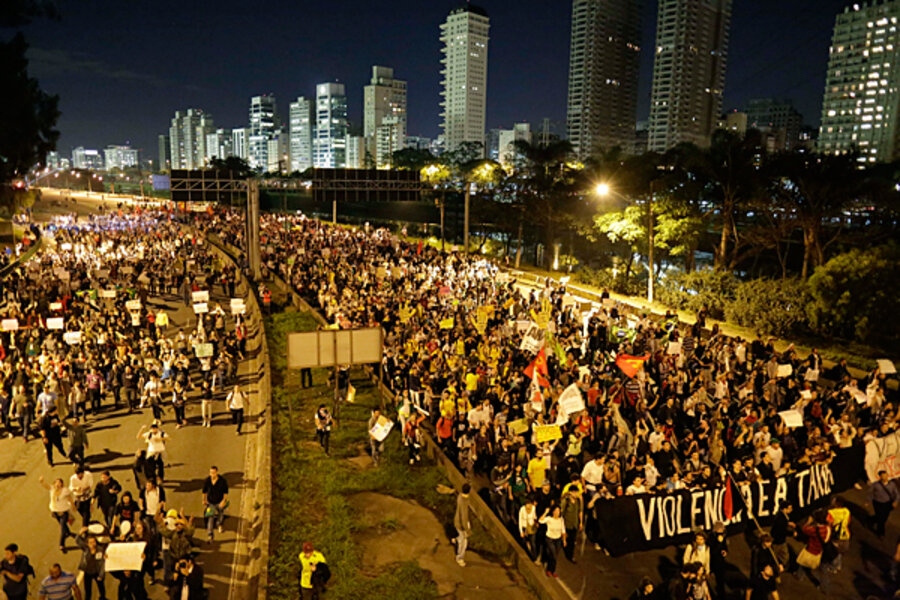Brazilians stage largest protests in 20 years, bearing a multitude of complaints
Loading...
| RIO DE JANEIRO
More than 200,000 Brazilians demonstrated in the streets in more than 20 cities last night in a show of frustration over public services, transportation, the country's role in hosting multiple international sporting events, and the harsh response by public officials and police to previous protests.
Protests started as early as April in the southern city of Porto Alegre, largely over the close to 10 cent increases in bus fares. But as the protests spread to cities around Brazil in recent weeks, often met with police repression and contempt from elected officials, the demonstrations morphed into a sweeping bitterness over the government’s responsiveness to citizens’ demands.
“Those who govern earn so much and they have no respect for us,” says Lucas Alves, a young protester in Rio de Janeiro. “Ten cents isn’t an excuse [for us to come to the streets]. It’s just one more thing.”
The nationwide protests are believed to be the largest in two decades. Brazil had a military dictatorship until 1985, and it's still rare to see spontaneous expressions of discontent by civil society. Demonstrations are more routinely organized by unions or political parties, but the recent uprisings – coordinated through social media and without a specific leader – may be part of a shift in how Brazilians express their frustrations and demands in a changing economy and growing democracy. Just last year nationwide protests developed in a similar way over proposed changes to a forestry code that would have amnestied illegal deforestation.
"Peaceful protests are legitimate and intrinsic to democracy," said President Dilma Rousseff, according to her spokeswoman. More demonstrations are scheduled for this week.
The current protests come right as Brazil hosts the FIFA Confederations Cup, a year before it will hold the World Cup and then, in 2016, the Summer Olympics. On Sunday, dressed as soccer fans and even carrying Turkish flags in solidarity with anti-government protests taking place there, hundreds of protesters in Rio initiated a demonstration near the Maracanã stadium. They were quickly dispersed with tear gas and rubber bullets from police, who then chased bands of demonstrators down nearby busy streets and into a public park, where families with children were subjected to tear gas alongside demonstrators.
Though demonstrations were largely peaceful, incidents of violence both by and against police arose in several cities. In Rio, at least 20 police officers were reported injured Monday in a confrontation over the occupation by protesters of the State Assembly. Four protesters were also reported wounded by gunshots, and a video by the Rio newspaper Extra reportedly shows a plainclothes officer firing into the streets during the protest.
The “stance of opposition and the use of police” in earlier protests galvanized demonstrators for Monday’s protests who may not have come simply over the bus fare hike, says Renata Florentino, a researcher who studies mega-events and a doctoral student in social sciences at the University of Campinas in São Paulo.
“These manifestations are about the general malaise on a series of issues,” says Ms. Florentino, adding that before Brazil became an international success story as an emerging economy, it was mired in debt, and demonstrators might not have so forcefully reacted against a raise in bus fare.
“Maybe in the ‘80s the population would even accept that we don’t have enough money, but after you construct 12 stadiums that look like they are from the time of the Pharaohs, they don’t accept that the mayor doesn’t have the money” to keep bus services affordable.
Ane Vallin came to Sunday’s protest near the Maracanã stadium wearing a Brazil jersey and covered in striped face paint, as though she were one of the soccer fans. “Taxes go up, but we don’t get anything,” Ms. Vallin says, complaining about government corruption and the sense that more police arrived to break up a protest next to a soccer stadium than are out keeping the streets safe on any given day. Gesturing toward the game, she says, “Brazil is not a country for Brazilians.”







